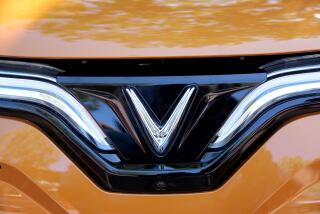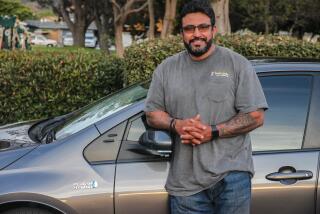PLACENTIA : Teen Builds a Car Plugged Into the Future
When El Dorado High School junior Lewis Regla needs to fill up his car, he pops open the gas cap. But instead of putting in a nozzle, he pulls out a 30-foot orange extension cord and plugs the 1984 blue Pontiac Fiero into an outlet in his parent’s garage.
With a top speed of just 60 m.p.h., no air-conditioning, and the inability to ever use running out of gas as an excuse for being late, Regla’s electric car, which he recently finished converting from a $200 junker, may not be every teen-ager’s dream machine.
But the quirks of building and owning an electric car are what attracted Regla to the project.
“I like being a pioneer in the field,” Regla said. “I look at it as sort of a technological challenge.”
Like most of the estimated 1,000 electric vehicles registered in California, Regla’s car was converted from a conventional, gas-powered automobile.
But while many of those cars were converted using kits sold at specialty automotive stores, the 17-year-old Regla designed and built his own battery-powered engine, motor and brake system.
“The point of this was to make my own design,” Regla said.
“I went through a lot of trial and error to get it right.”
Regla bought the Fiero in the spring of 1992.
While his friends got their driver’s licenses and began driving, he toiled nights and weekends in his garage.
Challenges he faced included fitting 15 batteries onto the car’s streamlined chassis and figuring out how to work the power brakes, which normally operate off the vacuum created by the gas engine.
Two-and-a-half years and an estimated $6,000 later, Regla finally completed his car last month. The first place he drove it to was the Department of Motor Vehicles office to get it registered.
If the project started with his desire to do something different, it was completed because of Regla’s longing to be like his friends.
“The rule was, I couldn’t get my driver’s license until this was done,” Regla said.
“That was a big incentive to finish.”
More to Read
Sign up for Essential California
The most important California stories and recommendations in your inbox every morning.
You may occasionally receive promotional content from the Los Angeles Times.










